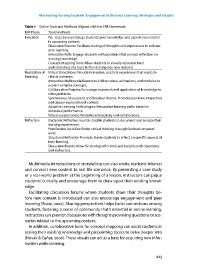Page 223 - International Perspectives on Effective Teaching and Learning in Digital Education
P. 223
Maximizing Nursing Students’ Engagement in Distance Learning: Strategies and Insights
Table 1 Online Tools and Methods Aligned with the ERR Framework
ERR Phase Tools/methods
Evocation Pre–class Surveys: Gauge students’ prior knowledge and experiences related
to upcoming content.
Discussion Forums: Facilitate sharing of thoughts and experiences to activate
prior learning.
Interactive Polls: Engage students with questions that prompt reflection on
existing knowledge.
Concept Mapping Tools: Allow students to visually represent their
understanding of a topic before delving into new material.
Realization of Virtual Simulations: Provide immersive, practical experiences that replicate
Meaning clinical scenarios.
Interactive Multimedia Resources: Utilize videos, animations, and modules to
explain complex concepts.
Collaborative Projects: Encourage teamwork and application of knowledge to
solve problems.
Synchronous Discussions and Breakout Rooms: Promote real–time interaction
and deeper exploration of content.
Adaptive Learning Technologies: Personalize learning paths based on
individual performance.
Virtual escape rooms: Promotes interactivity and collaboration.
Reflection Electronic Reflective Journals: Enable students to document and analyze their
learning experiences.
Peer Review Activities: Foster critical thinking through feedback on peers’
work.
Structured Reflection Prompts: Guide students to reflect on specific aspects of
their learning.
Discussion Boards: Allow for sharing reflections and insights with classmates
and instructors.
Multimedia introductions or storytelling can also evoke students’ interest
and connect new content to real-life scenarios. By presenting a case study
or a real-world problem at the beginning of a lesson, instructors can pique
students’ curiosity and encourage them to draw upon their existing knowl-
edge.
Facilitating discussion forums where students share their thoughts be-
fore new content is introduced can also encourage engagement and peer
learning (Rovai, ). Sharing perspectives helps build connections among
students, fostering a sense of community that’s essential in online learning.
Instructors can prompt discussions with thought-provoking questions or sce-
narios related to the upcoming content.
In addition, collaborative tools for concept mapping can assist students in
seeing their existing knowledge and pinpointing topics to delve deeper into
(Novak & Cañas, 8). These visuals can act as a base for acquiring new infor-
mation while learning.
3

